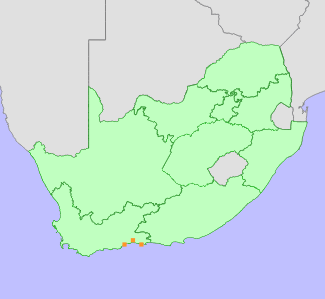|
Scientific Name | Nanobubon hypogaeum Magee |
Higher Classification | Dicotyledons |
Family | APIACEAE |
National Status |
Status and Criteria | Endangered B1ab(i,ii,iii,iv,v) |
Assessment Date | 2021/02/02 |
Assessor(s) | L. von Staden |
Justification | This rare, range-restricted (EOO 563 km²) coastal endemic is currently known from five locations and it is declining due to habitat loss to urban expansion, coastal development and competition from alien invasive plants. It is therefore listed as Endangered under criterion B. |
Distribution |
Endemism | South African endemic |
Provincial distribution | Western Cape |
Range | This species is endemic to the Western Cape Province, where it occurs from Mossel Bay to Knysna. |
Habitat and Ecology |
Major system | Terrestrial |
Major habitats | Knysna Sand Fynbos, Hartenbos Dune Thicket, Goukamma Dune Thicket |
Description | It is found in sandy coastal fynbos. |
Threats |
| It is threatened by ongoing habitat loss to urban expansion and coastal development, as well as competition from alien invasive plants. As this species' habitat is becoming more fragmented, fire is often excluded from remnant patches close to private properties. In such areas, plants can only be found in areas that are regularly cleared of overstorey shrubs such as along pathways and in firebreaks. |
Population |
Subpopulations are small, but this species is cryptic and easily overlooked. It is also apparently much more abundant in recently burnt veld, and declines rapidly as the surrounding vegetation matures, making it difficult to estimate population size.
|
Population trend | Decreasing |
Assessment History |
Taxon assessed |
Status and Criteria |
Citation/Red List version | | Nanobubon hypogaeum Magee | EN B1ab(i,ii,iii,iv,v) | 2013.1 | |
Bibliography |
Magee, A.R. 2012. Nanobubon hypogaeum (Apiaceae), a new contractile-rooted species from the Western Cape Province of South Africa. South African Journal of Botany 80:63-66.
|
Citation |
| von Staden, L. 2021. Nanobubon hypogaeum Magee. National Assessment: Red List of South African Plants version 2024.1. Accessed on 2025/11/30 |
 Comment on this assessment
Comment on this assessment


